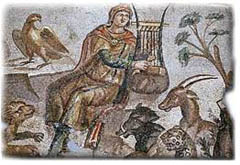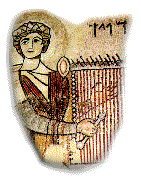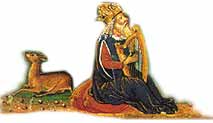| Orpheus,
the ancient Greek musician and poet, was the founder of the Greek
Mysteries. Orpheus, it is said, traveled to Egypt, invented the
alphabet, and was a priest of both Apollo and Dionysus. His music
not only had the power to stay the gates of death, but the celestial
harmonies which issued from his magical lyre were so beautiful
as to sway the beasts of the field, to move even the trees and
lifeless stones. In his essay "Pagan, Christian and Jewish
Elements in the Art of Ancient Synagogues," art historian
Bezalel Narkiss makes a connection between Orpheus and King David. |
 Orpheus,
the Thracian singer who moved rocks and trees and tamed wild beasts with his
music, was usually depicted as a young harp player wearing a Phrygian conical
peaked cap, seated on a rock, and surrounded by animals that were charmed by
his music. The numerous wall paintings, mosaic floors, and relief sculptures
of Orpheus in this posture were, of course, only a symbolic allusion to his
function as a savior who managed to enter the underworld and come out alive. Orpheus,
the Thracian singer who moved rocks and trees and tamed wild beasts with his
music, was usually depicted as a young harp player wearing a Phrygian conical
peaked cap, seated on a rock, and surrounded by animals that were charmed by
his music. The numerous wall paintings, mosaic floors, and relief sculptures
of Orpheus in this posture were, of course, only a symbolic allusion to his
function as a savior who managed to enter the underworld and come out alive.
The Pryhic cult that was personified by this mystical image of personal salvation
was widespread in the Roman Empire and included not only initiates of his cult,
but Jews and Christians as well. The many depictions in fourth century Rome's
early Christian catacombs (and later) of Orpheus charming the animals, do not
portray the Christians' belief in their salvation through Orpheus but rather
refer to Christ, who is disguised as the popular Orpheus.
The popular
figure with all his attibutes was depicted in early figure with all his
attributes was depicted in early Jewish art as well. Orpheus wearing a
Phrygian cap and playing a harp in front of some animals appear on the
second stage of the main panel above the Torah Ark in the third century
synagogue of Dura Europos. Here, too, the popular image of a musician
was probably taken to represent King David, the harpist, the ancestor
of the future Messiah, and annointed king and savior of the Nation of
Israel.

David
with harp, detail from Gaza synagogue floor
|
Evidence
for the existence of such a figure in Jewish art is found only later,
in the beginning of the sixth century, in the mosaic floor of the synagogue
at Gaza. There the harpiest confronted by animals is crowned rather than
donned with a Phrygian cap, and above his head is the Hebrew inscription
"David."
Thus
, the identification of a pagan cult with a Jewish or a Christian messianic
figure was very common in the syncreistic milieu of late antiquity, and
serves as but one example of the adoption by one cult of the pictorial
symbolic language of another. The Orphic figure symbolized for the Jews
an image of salvation and eternal life; it was legitimized by identifying
him with David the musician, the Messiah to come.
The Orphic salvation
differed from that of the Jews mainly in assuring the initiates of Orphism
a personal salvation, which, in fact, all other salvation sects, including
the Pauline Christians, also claimed. Jewish redemption was a national
one, and personal salvation could be found only in the salvation of
the whole nation. This special national Jewish redemption served as
a guideline for all Jewish literary and artistic expression during late
antiquity.

View
enlargement
|
From:
Bezalel Narkiss, Pagan, Christian, and Jewish Elements in the Art of
Ancient Synagogues in Lee I. Levine, editor, The Synagogue in Late
Antiquity, .
© 1987 by The Jewish Theological Seminary of America. |
KING
DAVID Table of Contents
|